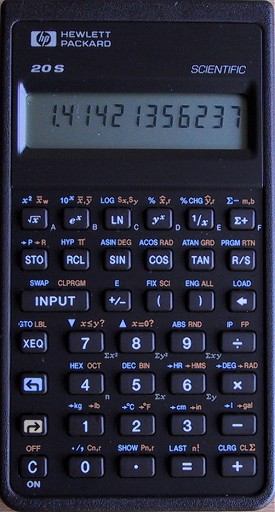hp 20s
| the 20s is a great little scientific calculator, it is one
of several similar slim models which are well built, light and easy to
carry. also, this model is not rpn! indeed, there is an '=' button and it
operates similar to older style casios as algebraic entry,
where you press 2 before square root rather than the other way round (ie
formula entry).
the display is clear with 12 digits and many handy annunciators, clearer than the 32sii due to the use of segments rather than dot matrix. currently, this model is still on sale new. i bought this one new before it is discontinued along with all the rest. this seem likely because although a fine machine, it costs around $50 when you can walk into a local store and buy a school style scientific model from casio or sharp for around $10 with similar features (although not as well made). see also hp30s. this does, however, have more than run of the mill scientific models. it is programmable for one thing (99 merged steps), with labels, subroutines and conditional jumps (unlike the modern trend to have no branches). it has number base conversions, hex, octal, dec & binary. the top row becomes the letters A-F in these modes making such entry a single keypress. the '.' button scrolls through the pages of digits in binary. for some reason the word size is 36 bits and this cant be changed, and there are no logical operations (eg and, or, not). there are a few unit conversions and sadly factorial cannot handle non-integers unlike most other hp machines way back to the 15c. also missing is the rather cool fractions mode of the 32sii. exponents can range up to +/-499 which is nice. |
 |
the input button is interesting because some binary operations like nCr require you to enter n, press input then enter r then press nCr. rather than, for example, enter n, press nCr, enter r, press =. most machine operate as the latter and indeed so does this for y^x.
a comprehensive set of 2D statistical functions are on offer including linear regression. these use 9 of the 10 memories (0-9).
programs in the memory can be assigned a label A-F which allow the routine to be executed from normal operation using xeq and then A-F.
the literature claims support for solve, integrations, 3x3 matrices and complex numbers. aha! well, these features are actually implemented as rom built-in programs that can be loaded into the normal program memory using load then A-F. this, of course, means that the program memory is occupied and if you wished to write a program that uses any of these, you would have to squeeze it in to what is left. the built-in programs are modestly sized and do leave some space, especially since solve and integrate require a small program to define the function. note here, that there is no formula option like the 32sii and other more advanced models like the 48g.
consequently, the ability of solve and integrate are somewhat simplified. solve uses a straightforward newton method with no refinements and integrate is just simpson's rule and there is no attempt to either use non-equal sample distances nor avoid calling the function at the limit points nor even track the error, unlike almost all other hp machines way back to the excellently designed 15c. but then its better like this than nothing, but dont expect quality quadrature. to be fair, it seems that all casio do is simpson's rule as well, eg fx-3900pv.